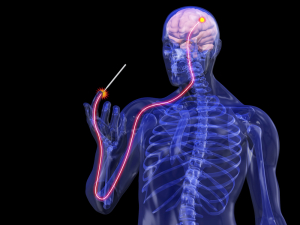By an early reactivation treatment following an injury complex regional pain syndromes (CRPS) can largely be avoided. They can be very devastating and can cause the most excruciating pains that I can think of. Unfortunately there are still many misconceptions about these well researched and defined pain syndromes.
Type I CRPS
Type I CRPS or reflex sympathetic disease (=RSD), as it used to be called, occurs about 2 or 3 months after an injury where the patient gets prolonged casting done (prolonged immobilization) or where a patient will not remobilize a limb because of a low pain threshold. It is in that period of immobilization that the sympathetic nervous system redistributes blood into deeper structures including bone. Bone demineralization takes place leading to osteoporosis and bone pain after a few months. The joint capsules shrink and the range of motion is significantly decreased. The muscle strength is disproportionately weak and shooting pains occur randomly.
Even the light touch of a bed sheet is leading to excruciating pain (called”allodynia” type pain). Unfortunately the negative cycle of pain and inactivity causes more severe pain and inactivity. Only active physiotherapy will help to prevent this CRPS from becoming chronic. There is only a window of opportunity of 2 or 3 months after the start of a CRPS where therapeutic intervention can turn everything around and lead to a successful resolution. Sometimes a pain specialist has to be consulted on a short-term basis and a sympathetic nerve block or an epidural injection may have to be done in an attempt to reverse the pain process.
Type II CRPS
With type II CRPS , which was called “causalgia” in the past, there is an underlying direct nerve damage either through a contusion injury to the nerve from outside or due to an internal cut from a fracture splinter.
In this case the pain is often more localized, but injections and physiotherapy might not be too successful. A referral to a pain specialist would be desirable (Ref. 2, p. 2073). In these cases a multidisciplinary team (through a pain clinic) defines the pain and treats it according to the patient’s needs with a combination therapy.
Often trigger point injections with local anesthetics are very useful in modifying pain pathways or even getting rid of pain entirely. Secondly, electroacupuncture has been shown to heal in a similar fashion. Thirdly, gabapentin (brand name: Neurontin) has been found to block certain pain receptors interfering with the perception of pain. Bone loss can be lessened with bone-loss medications, such as risedronate (Actonel) or calcitonin (Miacalcin). Along with antidepressants and the use of cognitive therapy methods it is possible to live with the pain and return to some form of daily functioning including a return to suitable work (Ref. 5).
References:
1.The Merck Manual, 7th edition, by M. H. Beers et al., Whitehouse Station, N.J., 1999. Chapter 49.
2. Goldman: Cecil Textbook of Medicine, 21st ed.(©2000)W.B.Saunders
3. Ferri: Ferri’s Clinical Advisor: Instant Diagnosis and Treatment, 2004 ed., Copyright © 2004 Mosby, Inc.
4. Rakel: Conn’s Current Therapy 2004, 56th ed., Copyright © 2004 Elsevier
5. Dr. Stephen Clarke, Clinical Assistant Professor in the Div. of Neurology of the University of BC/Vancouver/Canada, reviewed the use of gabapentin at the 50th Annual St. Paul’s Hospital Continuing Medical Education Conference for Primary Physicians, Nov. 16 – 19, 2004
6. Suzanne Somers: “Breakthrough” Eight Steps to Wellness– Life-altering Secrets from Today’s Cutting-edge Doctors”, Crown Publishers, 2008







